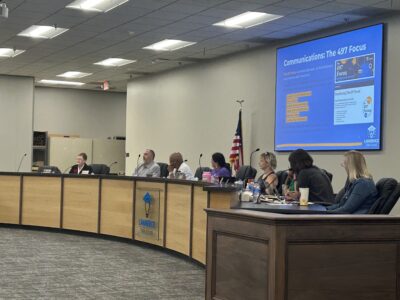Lawrence school board votes to advance 2 capital projects: creating a flexible high school program and expanding Langston Hughes Elementary

photo by: Bremen Keasey
Lawrence school board members and Superintendent Jeanice Swift (left) during the Wednesday night school board meeting.
Lawrence school board members voted Wednesday night to advance two major projects — a new flexible high school program and expansion of an elementary school — into a planning and development phase.
The board voted unanimously to advance the creation of a small high school program at the former Centennial Elementary School, 2145 Louisiana St., and the expansion of Langston Hughes Elementary, 1101 George Williams Way.
As the Journal-World reported, the district announced on Friday that it would explore these plans. During Wednesday night’s meeting, Superintendent Jeanice Swift presented details of the plans to the board for the first time.
The program at Centennial, which would be called “Choice Campus at Centennial,” would offer alternative high school programming in the day and evening. Swift said the program would aim to fit the needs of students who want a “nontraditional” approach, and that it could be used for students who want to earn more credits to graduate sooner or students who need to recover credits to stay on target to graduate in four years.
Swift said students would be able to choose this program to find an individualized learning approach that best suits them. She noted it was “unusual” for a district of Lawrence’s size to not have such a program, and she said this could be a good tool to help improve the district’s high school graduation rate.
“We really are excited about opening the door to a different way of learning based entirely on the profile of the student and what they need,” Swift said.
The other project that Swift introduced was an expansion for Langston Hughes Elementary. She said the school had been above its capacity for “a few years,” and the planned addition would add more classrooms and expand common spaces. Swift said the current capacity is about 550 students, while this year’s enrollment at the school is just under 600. The preliminary expansion plan would bring the school’s capacity to about 700, Swift said.
School board members expressed interest in the plans, but had some questions about the details. Board member Shannon Kimball asked Swift what other staffing resources it might take to implement the flexible high school program. Swift said there were no plans currently to add more staff members, but she added that that was “easy to say, not to do.” Swift also added that the proposals were “intentionally very general,” and if the board supported them, the staff would then “drill down the fine details.”
Board member Yolanda Franklin asked about how the district would market the flexible program, especially so students wouldn’t feel they are facing some stigma if they are behind their classmates. Swift said the district would come up with a model to address that with students that is similar to its adult education diploma completion program, describing it as an individualized plan that fits the student. Additionally, she said the plan would not be forced on students, but would be for students who decided that “I need something different, I need something small.”
Both of the projects at Centennial and Langston Hughes would be scheduled to open in August 2026, and they would use capital outlay funds that would not create a need for additional tax revenue.
Kimball noted that while Centennial was vacant and work could start right away there, school would be in session at Langston Hughes. Because of that, she felt the goal to open the expansion there by the next school year was an “aggressive timeline.”
Deputy Superintendent Larry Englebrick agreed with Kimball that the timeline was quick, but said that construction experts believed it could be done if the design work started soon. Englebrick said the plan would be to have some parts of construction at Langston Hughes begin in January or February.
Several board members said they were especially excited about the high school program. Kelly Jones said it was something she thought the district had needed for a while, and Bob Byers said it brings “another tool for the toolbox” to get a higher percentage of high school students to graduate.
• • •
In other business, school board members unanimously approved an agreement for the district’s education support professionals that will increase their base hourly wages by $1 for the 2025-2026 school year.
The new agreement, which the district and the Lawrence Education Association reached on Sept. 9, would set the new starting wage for these positions at $15.46 per hour. The raise means the salary pool for the education support professionals would increase by approximately $1.1 million, a 5.97% increase.
Jones thanked the school district’s leadership for “finding additional dollars” for the raises. She said she hoped to see future increases, noting that Kansas ranked 48th in the country on the average wage for education support professionals, and she asked the board to provide plans to bring those wages to a living wage by the 2026-27 school year. Jones said during the meeting that she used the “Living Wage Calculator” created by the Massachusetts Institute of Technology, which aims to calculate the basic costs of living for places across the country. According to that data, the living wage for one adult with no children in Douglas County would be $20.87 per hour.
As well as the increase in wages, the agreement outlined some other changes involving education support professionals, including allowing them to use a shared illness or catastrophic leave pool without having to donate any of their own time off.






